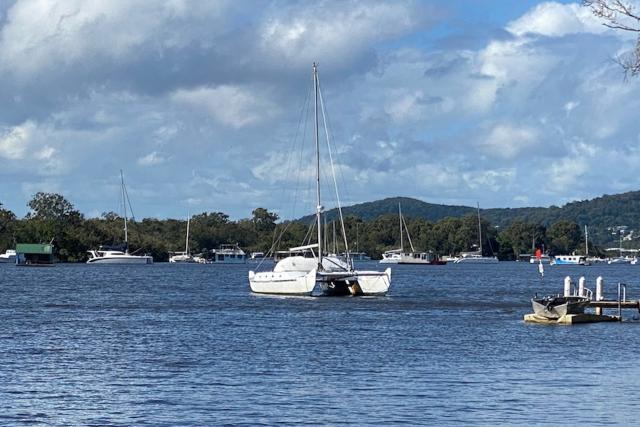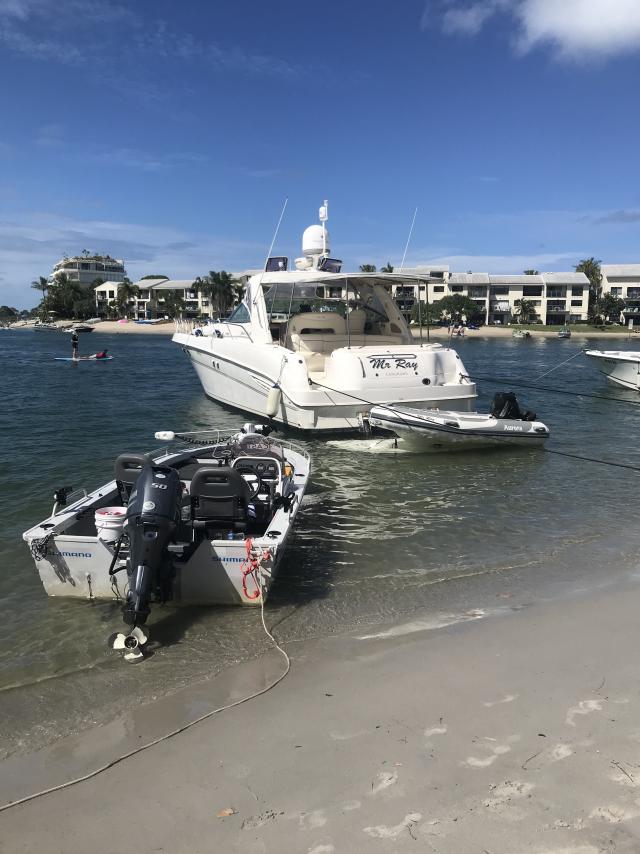While our brown and overflowing river had other things on its mind last week, a significant number of Noosa River stakeholders were building a head of steam over what they perceive as Maritime Safety Queensland’s failure to act on some of the biggest issues facing the river.
And, although some believe that a reduction of the powered craft speed limit is at the top of that list, an overwhelming majority cite our lack of a time limit on anchoring as the most pressing problem. As reported in Noosa Today on 12 August last year, the Noosa River Stakeholders Advisory Committee (NRSAC) recommended adoption of a 28-day anchoring limit each year. MSQ undertook to provide a detailed outline of a program for consultation, review and refinement of proposed regulations at the following committee meeting.
But, as one angry stakeholder told Noosa Today: “Six months have gone by, and the committee is still waiting. So is the Noosa community. Some waterways in Queensland have controls over where vessels can anchor, and the length of time they can anchor. Not in Noosa. There’s no time limit, that’s why the number of vessels is continuing to increase.
Our river is being used as a graveyard for wrecks and a parking lot for other vessels, many of them providing cheap holidays for their out-of-town owners.”
Nick Hluszko, chairman of the NRSAC subcommittee, agreed there was increasing frustration and disillusionment amongst river stakeholders at MSQ’s failure to act on anchoring.
Another stakeholder, who did not wish to be named, expanded on that sentiment: “There are a growing number of committee members, and those that they represent or connect with, who feel there is little tangible evidence of positive change happening. What the subcommittee is very worried about is that its very first recommendations for river use – anchoring, mooring and live-aboard vessels – will be bogged down or put in the too hard basket and that nothing happens.”
The river advisory committee was established by Noosa Council and MSQ at the instigation of Noosa Mayor Clare Stewart and Noosa MP Sandy Bolton in early 2021, and was initially met with a tide of optimism.
As one committee member told Noosa Today: “Contrary to the expectations of ongoing friction between old enemies, we actually found that we could put our differences aside and work together to solve the problems of the river.”
Other river stakeholders have praised Noosa Council for its active response to early recommendations on cleaning up the river bank of unauthorised structures and works in the Frying Pan area.
But one asked: “When can the community expect action from MSQ on the ongoing proliferation of anchored and unattended vessels?”
In a statement to Noosa Today, MSQ general manager Kell Dillon reaffirmed the agency’s commitment to the river.
“As co-chair of the Noosa River Stakeholder Advisory Committee with Noosa Shire Council, MSQ is committed to addressing all concerns raised by community members for the Noosa River.
“Factors to be considered for waterways management are complex, and banning, or placing restrictions on, activities such as anchoring in one waterway may have implications for others. Any regulatory changes require broad community engagement. Freedom of passage and, safe and equal access to the waterways are key considerations.“
Mr Dillon went on to outline programs and activities already implemented for the Noosa River, including establishing a dedicated Noosa Marine Officer position, increased presence on the waterways through the Maritime Enforcement Team in coordination with partner agencies, and a review of buoy moorings on the river.
He added that MSQ was also seeking public feedback on the proposal to reduce speed limits on the busy downstream reaches of the river and had written to key stakeholders.
Noosa Today understands some NRSAC members believe MSQ’s decision to look at speed limit reductions first is that such changes can be made at a local or regional MSQ management level – the low hanging fruit, as it were – whereas the other changes involve legislation that affects all Queensland waterways except those which have their own unique provision under the Act, such as the Gold Coast Waterways. This means unless separate legislation is also passed for the Noosa River, any changes have to be state-wide.
As MSQ’s Kell Dillon suggests, changing maritime law is not simple and carries with it the risk that anything that changes here could transfer the problem elsewhere.
For example, vessels dumped on anchor in the river today might end up behind K’gari or in the Maroochy or Mooloolah Rivers, or behind Bribie Island – the desirable waterways of South East Queensland.
But river stakeholders are concerned the bureaucratic process is being used as an excuse to do nothing.
Said one: “Meanwhile, Noosa’s reality is that anchoring problems are growing at a significant rate, with the most popular spots, such as Woods Bay and Hilton Esplanade, getting worse almost by the week.”
Noosa Today understands there is a genuine concern that unless legislative changes to anchoring are made with a sense of urgency here, not only will the damage be done, but fixing things will be significantly more difficult and expensive in the future.
Mr Hluszko said while MSQ has had to deal with Covid-related issues and staff and management changes, including a new chief executive officer, the Noosa community had reasonable expectations of receiving a clear pathway for positive change in the management of anchoring in the river very soon.
The full committee of the NRSAC is expected to discuss the issues with MSQ at their next meeting on 9 March.
People can email MSQNoosa@tmr.qld.gov.au for further details or have their say. Consultation is open until 16 March.








